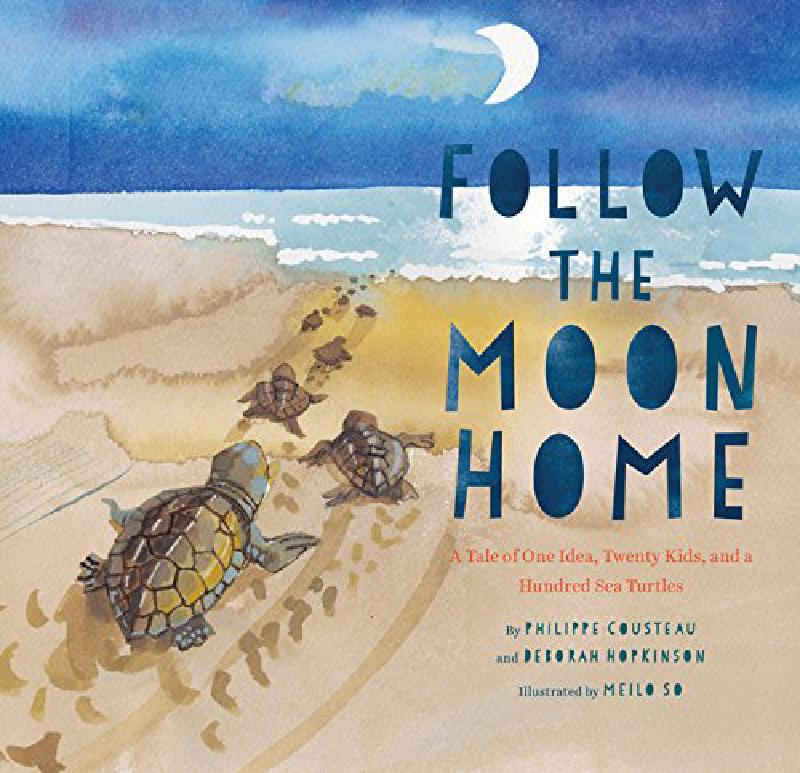Curriculum links
- Habitats
- Lifecycles
- Citizenship
Publisher’s summary
Acclaimed activist Philippe Cousteau and renowned author Deborah Hopkinson team up to offer a story of the powerful difference young people can make in the world. Meet Viv, who has a new home and a new school by the sea, and follow her as she finds her way in a new place and helps bring together a whole community to save the sea turtles of the South Carolina coast.
In Environmental Education
I’m sure many will relate to Viv’s nervousness and feeling lost at the start of the story. I often get a similar feeling when faced with the start of a big, open ended project, and approaching big environmental problems can be just as daunting. This book begins with Viv’s teacher breaking down the project into approachable steps, making this a great book for beginning a project-based unit.
A wonderful aspect of the story is how big a role community has in tackling the problem. Viv is briefly overwhemled when the problem is identified and it becomes clear just how many beach houses are causing it. But we turn a page and Viv’s community comes to the rescue. The class bands together behind the idea, breaking it down into managable parts, before they bring it to the wider community. It is easy to focus on raising awareness or individual action, but taking only these routes can feel ineffectual and lonely. It’s energizing to see Viv and the class inspire direct collective action from the whole community to really solve a problem.
Discussion ideas
Community - At the start of the book Viv is feeling nervous and lost. What other words might describe how Viv was feeling moving to a new place? After all the work with the rest of the class and meeting people living in town, how might Viv feel by the end of the summer? How might the other people in town feel after all that work to help the turtles?
What comes next? - The last step outlined by the teacher is to reflect on what they did and what they might do next. Their community action was a success! But turtles come back to nest on the same beach year after year. What might happen to the hatchlings next year? What could the class do to keep the momentum going?
Activity ideas
Moonlight paintings - The illustrator makes use of the special qualities of watercolour paints to create wonderfully ’loose’ pictures. The pictures of the moon over water are particularly striking. Experiment with drier and wetter brushwork capture the mood and texture of sand, wakes, and clouds. For the moon and reflections off waves, leave some areas of the page completely blank to keep the brilliant white of the page.
Recognizing achievements - Sometimes recognizing the work you’ve done in the past can help empower you to take on bigger problems. Think of a problem you’ve overcome in the past and write how you followed the action plan the teacher laid out. What was the problem? Did you need to find information or resources to help come up with a solution? What actions did you take? Record and tell the story of your achievement, and what you’d like your next step to be.
Support a local species - Viv’s project is to find a problem and come up with a plan of action. Research animals and plants in your area and see if any of them could use support. Local conservation and environmental charities can be a great resource for this, as many of them with either be monitoring how species are doing or can suggest organizations which do this. For example the UK Bumblebee Conservation Trust collects data from the public to help monitor how bumblebees are doing around the country. Find out what species might be in trouble in your area and come up with a plan of action to support it. You may even be able to arrange a call between your class and a scientist so they can ask questions directly.
Further exploration of themes in the book
Lights out for turtles
Lights out for sea turtles - Sea Turtle Conservancy
Behaviour of loggerhead sea turtles on an urban beach: Hatchling orientation - JSTOR
Project-based learning
What is Project-based Learning - PBL works
Project-based learning - Edutopia
More about the book
About the author - DeborahHopkinson.com
More activities and resources for Follow The Moon Home - teachingbooks.net
Tried any activities?
If you’ve used this book with your class we’d love to hear about it! Photos, stories, comments, or suggestions. We love them all!

